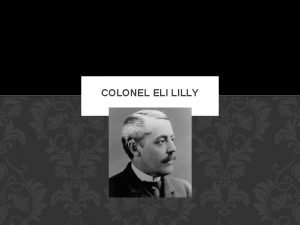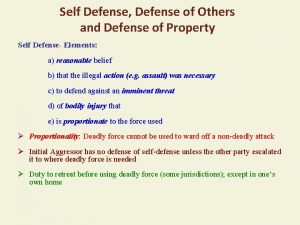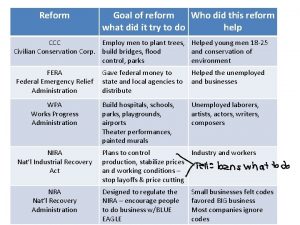THE HUNGARIAN DEFENSE REVIEW AND DEFENSE REFORM Colonel
















- Slides: 16

THE HUNGARIAN DEFENSE REVIEW AND DEFENSE REFORM Colonel Gabor Nagy Deputy Chief for Integration, HU Mo. D Defense Staff 6 November 2003

Background • Changing strategic security environment (11 September, Prague Summit, NATO enlargement credible ally) • Loss of credibility and reliability in the Alliance • Growing gap between allied obligations and delivered military capabilities • The current force structure is unaffordable • Recognition of incoherence in plans – Increasing cost of overheads – Limited support costs to deliver military capability 2

Main objectives • The vision: „To qualitatively contribute to the Euro-Atlantic peace and security” • To balance the new security policy challenges and available resources • To deliver a properly costed 10 year plan • To develop realistic, affordable, required military capabilities • To transform to all volunteer forces 3

The ten-step process 1. Agree Foreign and Security Policy objectives (based on threat analysis) 2. Agree Defence Objectives 3. Agree Military Missions and Tasks 4. Agree Planning Assumptions 5. Identify Required Military Capabilities 6. Identify the full implications 7. Develop credible and robust costing 8. Identify options 9. Decide on priorities 10. Allocation of resources and finalisation of Master 4 Plan

Basic assumptions • Threats: – No strategic attack on NATO in 15 -20 years – No conventional attack on Hungary in 5 -10 years • Potential threats – Regional instability, South-East Europe, Mediterranean, – Terrorism, – Proliferation WMDs, their components, precursors, delivery means, illegal arms trade • Risks – Illegal and mass migration, organized crime, drugs-trade, environmental and other risks 5

Tasks of the Hungarian Defense Forces 1. 1. Home defense 1. 2. Common defense, assisting other member state 1. 3. Common defense, against strategic attack on NATO 1. NATO Article 5 Operations 2. 3. Border security Host Nation Support 4. Participation in international crisis management, peace operations 5. 6. 7. 8. 9. 10. 11. 12. 13. 4. 1. Peace support operations (military observer missions) 4. 2. Peacekeeping operations 4. 3. Peace enforcement operations Participation in international crisis management, other international operations. Other non-war-fighting operations e. g. Fighting against terrorism Bilateral, multilateral co-operation International treaties, arms control Humanitarian assistance Information collection, processing and security 11. 1. Disaster relief 11. 2. Explosive Ordnance Disposal Assistance for civil authorities 11. 3. Search and Rescue 11. 4. State of Emergency tasks Air Policing Frequency Management 6

Level of ambition Home defense tasks the whole armed forces Border security Air policing • Brigade HQ • Battalion task force • Combat helos • Artillery • GBAD Ceremonial, moral • Ceremonial battalion • Military music Home tasks Assist civilian authorities • EOD • SAR • Air C 2 • Radars • Fighters • STO • Infrastructure Host Nation Support • Air bases • Bridging • CBNR • Military hospitals • Logistics • Security (guard) forces 7

Level of ambition One brigade, no rotation, one shot NATO Article 5, EU operations, deployment with all CS and CSS elements Four Gripens for Air -to-Ground tasks Operations abroad Four combat helos Two battalion size forces, max 1600 persons, A-B-C rotation „Niche capabilities” (Med, CIMIC, CBNR, SOF) Specialization Bridging battalion Water purification coy MP battalion One shot no rotation 8

Force development considerations • Not territorial defense – but collective security • Operations in Allied (International) Coalition – expeditionary forces • Modular, multifunctional, flexible • Number of existing deployable combat elements will be increasing gradually • Combat support and combat service support capabilities will be enhancing • Complementary force development, strategic lift, air refueling, theatre intelligence (AGS), theatre air defense on Alliance/international basis • GDP share from 2006 1, 81 % • Focus on Alliance shortfalls (bridging, MP, water purification) • Focus on „Niche” capabilities (medical, CIMIC, NBC, SOF) • Replace old, obsolete WP equipment with NATO compatible systems • Corps level support artillery, EW, AIFVs eliminated, MBTs 9 downsized, • Retain military capabilities justified by the level of

The force structure • • Land Forces 2 light infantry brigades, with CS, CSS elements SOF battalion Reconnaissance battalion, long range recce included Engineer brigade, bridging and water purification capabilities included Tank battalion NBC battalion Logistic regiment Basic training center • • Air Force Air Base (MOB), all fix-winged assets, GRIPEN (Mi. G-29 until 2009) transport, training aircraft Air Base (MOB) reserve Helicopter Base, Mi 24, Mi-8/17, support and logistic elements Ground Air Defense Brigade (KUB+MISTRAL) C 2, support and logistic elements Air Surveillance Regiment Air Command Center Support battalion • • • Logistics General Logistic Support Supply Group Dangerous Materiel Supply Group Support Regiment Explosive Ordnance Disposal and Flotilla Regiment Movement Coordination Centre Printing Office METEO Service Mapping Service CIMIC Equipment Surplus Storage Facility (Nyírtelek) Modular, multifunctional, flexible Remarkable increase of deployable elements 10 Enhanced combat support (CS), combat service support (CSS)

Equipment replacement policy Type Procurement Withdrawal by 2006 T-72 MBT by 2013 0 238 0 BMP-1 AIFV replaced with armoured wheeled vehicle 490+12 BRM-1 K 0 BTR-80 APC NATO compatible modernization 300 0 308 0 62 0 71 immediately, 82 by 2006 0 114 0 D-20 152 mm gunhowitzer BM-21 MLRS 122 mm SP howitzer Mortars replaced with 105 mm towed howitzer 120 mm, 60 mm mortars Maljutka ATM Konkursz ATM replaced after 2010 0 24 Mi. G-29 fighter replaced with Gripen after 2005 13 (2003) 14(200 9) buying flight hours after withdrawal 3 6 (2009) 3 9 (2009) NATO compatible maintenance and modernization 18 0 Mi-17 maintenance and procurement 26 L-39 trainer aircraft JAK-52 primary trainer aircraft Mi-24 SAH Mi-8 CSH 11 0

Principles for personnel transfers • Actual strength: 42 000 (authorization 44 400) • Conscripts: 9100 (authorization 7800) • Planned authorizations: 2006 2010 2013 MH 500 HM 500 Σ 000 30 000 28 000 26 5 000 4 000 3 35 000 32 000 30 • Quality retention principles: – – – Outstanding evaluation/progress report and performance; Required military education, skills + qualifications Foreign languages (high level or STANAG) Education abroad or service abroad Various professional experiences, unit-level-service experiences 12

Social and economic affects • Base closures, purchasing power, demand for goods and commodities are decreasing in the area • Family transfers free up jobs, school- and childcare places in the abandoned garrison, but appear as new demands elsewhere • Locally hired employees are loosing their job • Employment redundant personnel requires coordination • Equipment development, modernization resources are limited, forced elimination of military capabilities • 10 -15 thousand personnel decrease in ten years, unavoidable base closures, cautious dialogue with 13 municipalities is crucial

What we might win? ü By 2006 9 NATO-compatible, manned, equipped, deployable, flexible, trained, and willing infantry battalions (of which one is reconnaissance and another one is ranger type SOF) ü Modern fighters, 3 D radars, modernized and/or new combat and transport helicopters ü Specialization (water purification, bridging, military police) ü Meet important allied requirements (NRF, FP-2004, PCC ) ü Advanced modernization (organizational, operational, equipment) Ø Extended, enhanced fire power Ø Increased deployability Ø More simple sustainment ü In line with NATO instructions ü Based on existing capabilities, progresses ü Decrease affects on personnel (capability loss by transfer to another garrison) ü More simple, effective recruitment system 14 ü Balanced resource plan

How to proceed? • • • Government decision 24 Sep 2003 Draft the ten-year-plan Programming all ten-year-plan elements Prepare and distribute TOEs Revise 2004 -2006 budget plan (Done) Brief parliamentary parties, factions Continue discussions with municipalities NATO trilateral in November (FP-2004) Present proposals to amend defense-related Parliamentary resolutions (Fall) 15

„To qualitatively contribute to the Euro-Atlantic peace and security”
 Th and tc cells
Th and tc cells Eleanor van tassel brush
Eleanor van tassel brush One hundred years of solitude family tree
One hundred years of solitude family tree Colonel mackenzie comanche
Colonel mackenzie comanche Finn fails nnn
Finn fails nnn Colonel tye
Colonel tye Grade colonel
Grade colonel Colonelby
Colonelby Colonel by course selection
Colonel by course selection Mr. medbourne character analysis
Mr. medbourne character analysis Colonel john wheeler
Colonel john wheeler Coopers colors of awareness
Coopers colors of awareness Col. frank skimmerhorn
Col. frank skimmerhorn Symbols in dr heidegger's experiment
Symbols in dr heidegger's experiment Would you rather pills
Would you rather pills Colonel hardenbergh
Colonel hardenbergh Col matthew hepburn
Col matthew hepburn































